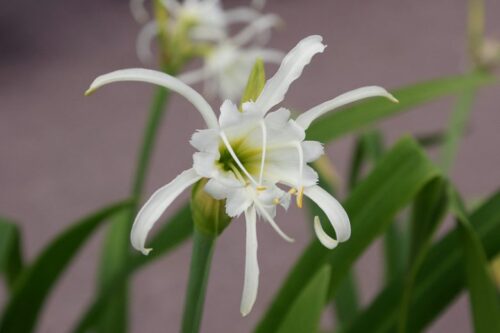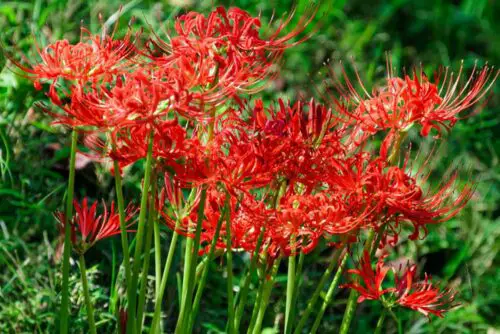The spider lily leaves are turning yellow due to overwatering or lack of sunlight. This can be caused by excessive water or insufficient light.
Yellowing leaves in spider lilies can indicate that the plant is receiving too much water or not enough sunlight.
Understanding Spider Lilies
Characteristics Of Spider Lilies
Spider lilies are known for their unique appearance and striking colors.
- Long, narrow petals that resemble spider legs
- Blooms in shades of white, pink, or red
- Thrive in well-draining soil and partial shade
Causes Of Yellowing Spider Lily Leaves
Yellowing leaves in spider lilies can be due to various factors:
- Overwatering leading to root rot
- Insufficient sunlight causing nutrient deficiencies
- Pests like spider mites or aphids feeding on leaves
Preventing And Treating Yellow Leaves
To maintain healthy spider lilies:
- Ensure well-draining soil and proper watering
- Provide adequate sunlight for photosynthesis
- Regularly inspect plants for pests and treat promptly

Credit: www.gardenia.net
Common Spider Lily Issues
Notice your spider lily leaves turning yellow? Common culprits include overwatering, lack of sunlight, or root rot. Check soil moisture and light exposure to prevent further yellowing.
Spider lilies are beautiful and exotic plants known for their unique flowers and striking foliage. However, like any plant, spider lilies may encounter certain issues that can affect their health and appearance. One common problem that spider lily owners often face is the yellowing of their leaves. In this section, we will explore this issue in detail and discuss the potential causes behind it.Yellowing Leaves: A Visual Symptom
The sight of yellowing leaves on your spider lilies can be alarming, but it is an important visual clue that something may be amiss. Yellow leaves are a common symptom in plants when they are experiencing stress, nutrient deficiencies, or disease. By recognizing and understanding this visual cue, you can take appropriate actions to restore your spider lilies’ health.Potential Causes Of Yellowing Leaves
There are several possible causes for yellowing leaves in spider lilies. Identifying the root cause is crucial in addressing the issue effectively. Here are some common potential causes: 1. Overwatering: Spider lilies prefer well-drained soil, and overwatering can lead to root rot and yellowing leaves. Ensure that your spider lilies’ soil is moist but not soggy, and avoid excessive watering. 2. Underwatering: On the other hand, if spider lilies do not receive enough water, their leaves can turn yellow and eventually brown. Make sure to water your spider lilies regularly, especially during dry periods. 3. Insufficient sunlight: Spider lilies thrive in bright but indirect sunlight. If they are not exposed to enough light, their leaves may start to yellow. Find a suitable location that provides ample light for your spider lilies. 4. Nutrient deficiencies: Spider lilies require essential nutrients like nitrogen, phosphorus, and potassium for healthy growth. If these nutrients are lacking in the soil, the leaves may turn yellow. Consider fertilizing your spider lilies with a balanced fertilizer that contains these essential nutrients. 5. Pest infestation: Spider lilies can fall victim to pests such as aphids, mites, or spider mites. These pests can cause damage to the plant’s leaves, leading to yellowing. Regularly inspect your spider lilies for any signs of pest infestation and take appropriate measures to eradicate them. 6. Disease: Certain diseases, such as fungal infections or viral diseases, can cause the leaves of spider lilies to turn yellow. Monitor your plants closely for any signs of disease, including yellow spots, black spots, or unusual growth, and seek professional advice if necessary. By understanding the potential causes behind yellowing leaves in spider lilies, you can take proactive measures to address the issue and maintain the health and vibrancy of your plants. Remember to provide proper care, including appropriate watering, sufficient sunlight, and regular inspections to keep your spider lilies in optimal condition.Nutritional Deficiencies
Spider lilies, like many plants, require a balanced diet to thrive and remain healthy. When spider lily leaves start turning yellow, it can be a sign of various nutritional deficiencies. These deficiencies can impact the plant’s growth, flowering, and overall health. It’s crucial to understand the impact of nutritional deficiencies on spider lilies and be able to identify the symptoms to provide the necessary care.
Impact On Spider Lilies
A deficiency in essential nutrients can have a detrimental effect on spider lilies. Lack of proper nutrition can lead to stunted growth, reduced flowering, and overall weakened vitality. The plant’s ability to resist diseases and pests may also be compromised, making it more susceptible to environmental stresses.
Identifying Deficiency Symptoms
Recognizing the symptoms of nutritional deficiencies in spider lilies is crucial for effective intervention. Specific deficiencies can manifest through distinct signs. Understanding these symptoms can help in determining the appropriate course of action to rectify the issue and restore the plant’s health.
Overwatering Vs. Underwatering
When it comes to the health of your spider lilies, it’s essential to understand the delicate balance between overwatering and underwatering. Both situations can lead to yellowing leaves and affect the overall well-being of your plants. Let’s take a closer look at the effects of overwatering and underwatering, and how to find the right balance for your spider lilies.
Effects On Spider Lilies
Overwatering can lead to yellowing leaves as it deprives the plant’s roots of oxygen, causing them to suffocate and eventually rot. On the other hand, underwatering can cause the leaves to turn yellow and wilt as the plant struggles to maintain adequate hydration levels. Both scenarios can weaken the plant and make it more susceptible to diseases and pest infestations.
Finding The Right Balance
It’s crucial to ensure that your spider lilies receive just the right amount of water. Overwatering and underwatering can both have detrimental effects on the plants’ health, so finding the perfect balance is key. Consider the moisture requirements of your specific spider lily variety and the environmental conditions in which they are growing. Use a well-draining soil mix and monitor the moisture levels regularly to avoid extremes.
Pests And Diseases
Spider lilies are known for their stunning blooms and attractive foliage. However, if you notice that the leaves of your spider lilies are turning yellow, it could be an indication of pests or diseases affecting your plants. In this section, we will explore the common pests that can affect spider lilies and discuss preventive measures and treatments to help you maintain healthy plants.
Common Pests That Affect Spider Lilies
Spider lilies can fall victim to several pests that can cause the leaves to turn yellow. Here are some common pests you should be aware of:
- Aphids: These tiny insects feed on the sap of leaves and can cause yellowing and distortion of the foliage.
- Spider mites: These minuscule pests also feed on the sap of leaves, causing yellow spots and webbing to appear.
- Scale insects: These pests attach themselves to the leaves and stems, feeding on the plant’s sap and causing yellow patches.
- Thrips: These slender insects may leave silver streaks on the leaves and cause them to turn yellow.
If you observe any of these pests on your spider lilies, it’s essential to take immediate action to prevent further damage.
Preventive Measures And Treatments
To keep your spider lilies healthy and prevent yellowing of the leaves due to pests, consider the following preventive measures and treatments:
- Regular inspection: Check your spider lilies frequently for any signs of pests. Early detection is crucial for effective pest control.
- Pruning and removing infested leaves: If you spot any yellow, wilted, or infested leaves, promptly remove them and dispose of them away from your garden to prevent the spread of pests.
- Natural predators: Encourage natural predators like ladybugs and lacewings, which feed on pests, by planting companion plants and avoiding the use of harmful pesticides.
- Insecticidal soaps or oils: If the infestation is severe, you can opt for insecticidal soaps or oils specifically formulated for controlling pests on houseplants. Always read and follow the instructions provided.
- Watering and fertilization: Proper watering and fertilizing practices can promote plant health and make your spider lilies less susceptible to pests. Avoid overwatering, as excess moisture can attract pests.
By implementing these preventive measures and treatments, you can effectively combat pests and maintain vibrant, green foliage on your spider lilies.

Credit: www.thespruce.com
Light And Temperature Issues
Yellowing spider lily leaves can be a sign of light and temperature issues.
Optimal Light Conditions For Spider Lilies
Spider lilies thrive in indirect sunlight as direct sunlight can lead to yellowing leaves.
Temperature Considerations
Spider lilies prefer temperatures between 60-75°F; extreme temperatures can cause yellowing.
Soil Quality Matters
Yellowing spider lily leaves can be distressing, but the solution might lie in the quality of the soil they are planted in. Adequate soil conditions are crucial for the health and vibrancy of your spider lilies.
Choosing The Right Soil For Spider Lilies
- Opt for well-draining, loamy soil for your spider lilies.
- Avoid heavy soil that can lead to waterlogging.
- Mix in organic matter like compost to improve soil structure.
Importance Of Proper Drainage
- Good drainage is essential to prevent water stagnation.
- Enhanced drainage promotes healthy root growth.
- Consider raised beds for better water drainage.
Pruning And Maintenance
Proper pruning and maintenance are essential for keeping your spider lily plants healthy and vibrant. By following these practical tips for proper pruning and regular maintenance practices, you can address the issue of yellowing leaves and ensure the overall health of your plants.
Practical Tips For Proper Pruning
When it comes to pruning your spider lily plants, it is important to follow a few key guidelines to promote healthy growth and prevent the yellowing of leaves:
- Remove dead or damaged leaves: Regularly inspect your spider lily plants and remove any dead or damaged leaves. These leaves not only detract from the aesthetic appeal but can also invite pests and diseases.
- Prune overcrowded foliage: If you notice overcrowding of foliage, thin it out by carefully removing excess leaves. This will enhance air circulation, prevent moisture buildup, and reduce the risk of fungal diseases.
- Trim spent flower stalks: After your spider lily plants have finished flowering, trim the spent flower stalks near the base. This will redirect energy towards new growth and prevent the plant from wasting resources on producing seeds.
Regular Maintenance Practices
In addition to pruning, incorporating regular maintenance practices into your routine can greatly contribute to the overall health and vitality of your spider lily plants. Consider the following maintenance tips:
- Provide proper watering: Spider lilies prefer moist but well-drained soil. Water deeply and allow the soil to dry slightly between waterings, ensuring that the plant is not sitting in waterlogged conditions.
- Fertilize appropriately: Feed your spider lily plants with a balanced fertilizer designed for flowering plants. Follow the manufacturer’s instructions for application rates and frequency, taking care not to over-fertilize as this can lead to nutrient imbalances.
- Manage pests and diseases: Regularly inspect your plants for any signs of pests or diseases, such as aphids or fungal infections. If necessary, treat them promptly using appropriate organic or chemical remedies.
- Provide adequate light: Spider lilies thrive in bright, indirect light. Ensure that they receive sufficient sunlight throughout the day, placing them near windows or in well-lit areas of your garden.
By giving attention to proper pruning techniques and incorporating regular maintenance practices, you can help prevent yellowing leaves and enjoy flourishing spider lily plants that add a touch of beauty and elegance to your garden.
Reviving Yellowing Spider Lily Leaves
Step-by-step Recovery Guide
If your spider lily leaves have turned yellow, don’t panic. There are measures you can take to revive them and restore their vibrant green color. Follow this step-by-step recovery guide to bring your spider lilies back to their healthy state.
Identify The Problem
- Check for overwatering or underwatering
- Assess soil drainage and conditions
- Inspect for pest infestation or diseases
Adjusting Watering And Drainage
- Allow the top layer of the soil to dry out before watering
- Ensure proper drainage in the plant’s pot or garden bed
Soil Nutrient Boost
- Consider applying a balanced fertilizer for flowering plants
- Follow the recommended dosage to avoid over-fertilization
Inspecting For Pest Infestation
Look for signs of spider mites, aphids, or other common garden pests. Treat any infestations with appropriate insecticidal soap or neem oil.
Disease Management
If you suspect a disease, remove any affected leaves and treat with a fungicide or other suitable remedy.

Credit: www.planetnatural.com
Future Care And Preventive Measures
Long-term Strategies For Healthy Spider Lilies
Proactively caring for your spider lilies can prevent leaves from turning yellow. Here are some long-term strategies:
- Ensure proper drainage to prevent waterlogging.
- Regularly inspect leaves for pests and diseases.
- Apply a balanced fertilizer during the growing season.
- Provide ample sunlight without direct exposure to harsh midday rays.
- Consider repotting if the current pot is crowded or if the soil has degraded.
Avoiding Yellow Leaves In The Future
To avoid the recurrence of yellow leaves in your spider lilies, it’s crucial to implement preventive measures. Here’s what you can do:
- Monitor soil moisture levels consistently and adjust watering as needed.
- Regularly prune and remove any yellow or diseased leaves.
- Keep an eye out for signs of pests and promptly address any infestations.
- Ensure proper air circulation around your plants to discourage fungal growth.
- Implement a regular inspection schedule to proactively catch any issues before they escalate.
Frequently Asked Questions For Why Are My Spider Lily Leaves Turning Yellow
Why Are The Leaves Of My Spider Lily Turning Yellow?
The yellowing of spider lily leaves could be due to overwatering, insufficient light, or a nutrient deficiency.
How Often Should I Water My Spider Lily?
Water spider lilies when the top inch of the soil feels dry, typically every 1-2 weeks.
What Light Conditions Do Spider Lilies Prefer?
Spider lilies thrive in bright, indirect sunlight but can tolerate partial shade.
What Nutrients Do Spider Lilies Require?
Spider lilies benefit from a balanced fertilizer with a higher phosphorus content for optimal bloom.
Are Yellow Leaves A Sign Of Disease In Spider Lilies?
Yellowing leaves can indicate a disease, but more commonly, it’s due to cultural issues like overwatering.
How Do I Prevent Spider Lily Leaves From Turning Yellow?
Ensure well-draining soil, proper watering, adequate sunlight, and regular fertilization to prevent yellowing.
Can I Revive Yellow Spider Lily Leaves?
Trim the yellow leaves, adjust care, and the plant may produce new healthy foliage.
Conclusion
Understanding why spider lily leaves turn yellow is crucial for maintaining the health of your plants. Whether it’s due to overwatering, nutrient deficiencies, pests, or disease, identifying the cause and taking appropriate action can help restore vibrant green leaves to your spider lilies.
By implementing the necessary care and providing a suitable environment, you can ensure the long-term vitality of your spider lilies and enjoy their stunning beauty.
